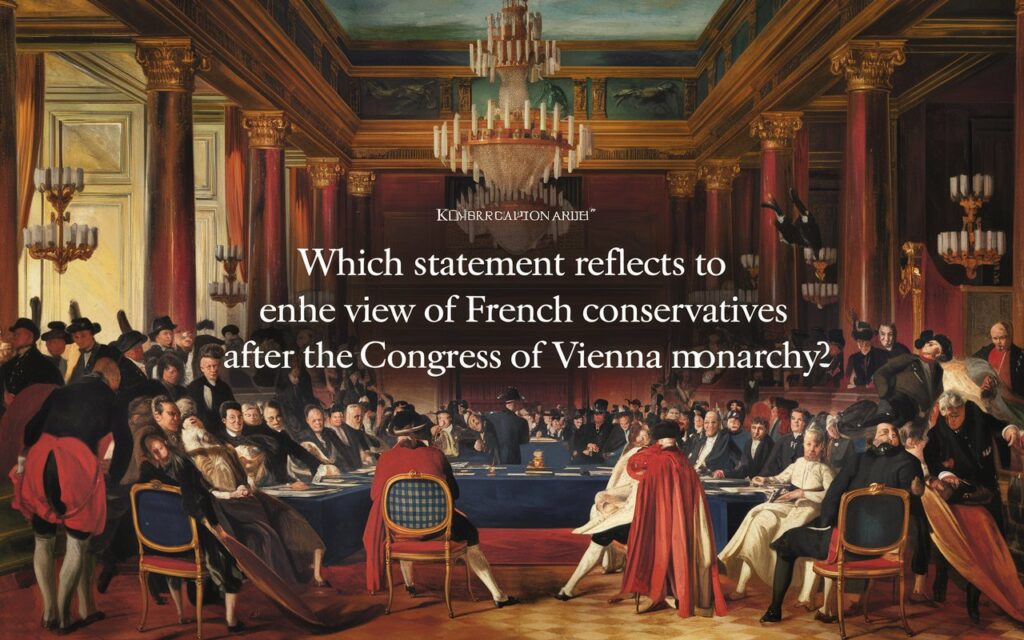The Congress of Vienna (1814-1815) was a turning point in European history, shaping the political landscape for decades. After Napoleon’s defeat, European powers sought to restore order and prevent future revolutions. This was particularly important for French conservatives, who desired stability and a return to traditional values.
Table of Biography:
| Aspect | Details |
|---|---|
| Topic | Which statement reflects the view of French conservatives after the Congress of Vienna? |
| Time Period | 1814-1815 (Post-Napoleonic Era) |
| Main Objective | Restore monarchy and maintain stability in France and Europe |
| Key Supporters | Bourbon monarchy, Ultra-royalists, Aristocracy |
| Opposition | Liberals, Republicans, Revolutionaries |
| Core Beliefs | Traditional monarchy, Anti-revolution, Social hierarchy |
| Influence | Led to conservative policies and suppression of revolutionary ideas |
| Historical Context | Congress of Vienna aimed to balance power and prevent future upheavals |
| Similar Movements | Austrian and Russian conservatism under Metternich and Tsar Alexander I |
| Long-Term Impact | Tensions led to later revolutions in 1830 and 1848 |
What Was the Congress of Vienna?
The Congress of Vienna was a gathering of European leaders, including representatives from Austria, Russia, Prussia, and Britain, along with France’s newly restored Bourbon monarchy. The primary aim was to reshape Europe after the Napoleonic Wars and restore the balance of power. The Congress sought to prevent the rise of another dominant figure like Napoleon and to reinforce monarchies that had been overthrown during the French Revolution.
French Conservatives and Their Views After the Congress
French conservatives were strongly aligned with the goals of the Congress. Their main priorities included:
- Restoring the Monarchy: Conservatives supported the return of King Louis XVIII and the Bourbon dynasty, believing that hereditary rule was essential for political stability.
- Opposing Revolutionary Ideals: They viewed the French Revolution and Napoleonic rule as sources of chaos and sought to eliminate any influence of liberal or republican ideals.
- Preserving Traditional Institutions: Conservatives prioritized the church’s power, aristocracy, and monarchy, believing these institutions provided stability.
- Resisting Change: While some conservatives were open to gradual reforms, they largely opposed sudden social or political transformations that could destabilize France.
Which Statement Best Reflects Their Views?
The statement that best reflects the views of French conservatives after the Congress of Vienna is:
“To Re-Establish Peace and Stability in Europe.”
This was the ultimate goal of French conservatives. They believed peace and stability could only be achieved by undoing the effects of the Revolution and Napoleon’s rule. They sought a return to the monarchy, suppression of liberal movements, and a rigid social hierarchy that limited political participation to the elite.

Why Did Conservatives Prioritize Stability?
The French Revolution (1789-1799) and the Napoleonic Wars brought radical change, violence, and instability. The execution of King Louis XVI, the Reign of Terror, and Napoleon’s rise and fall left France in turmoil. Conservatives believed restoring the monarchy and traditional institutions was the only way to prevent further upheaval.
Key Concerns of French Conservatives:
- Fear of Another Revolution: Conservatives wanted to prevent another uprising like the Revolution of 1789.
- Desire for Social Order: They believed a rigid social hierarchy would ensure long-term stability.
- Opposition to Liberalism and Nationalism: Liberal ideas such as constitutional government and individual rights were considered dangerous threats to monarchy.
- Support for International Alliances: The Congress of Vienna established the Concert of Europe, a system where significant powers would work together to maintain stability and suppress revolutionary movements.
How Did These Views Shape France?
After the Congress, the Bourbon monarchy was restored under King Louis XVIII. However, he had to adopt a constitutional charter that allowed limited freedoms. Conservatives, particularly the ultra-royalists, pushed for more muscular monarchical control and suppression of liberal ideas. This led to tensions between conservatives and more moderate factions within France.
Policies That Reflected Conservative Views:
- Censorship of the Press: Restricting newspapers to prevent the spread of liberal or revolutionary ideas.
- Restriction of Political Participation: Only the wealthy elite had political power, limiting democracy.
- Reinforcement of the Catholic Church’s Authority: The church regained influence in education and social affairs.
- Suppression of Protests and Revolutions: The government quickly crushed Any signs of rebellion.
Were French Conservatives Completely Against Change?
Not all conservatives were entirely resistant to reform. Some moderate conservatives accepted the idea of limited constitutional monarchy, where the king ruled alongside a parliamentary system. However, extreme conservatives—often referred to as ultra-royalists—wanted absolute monarchy restored with no concessions to liberalism.
Comparison With Other European Conservatives
French conservatives shared many views with conservatives across Europe, especially in Austria, Russia, and Prussia. The Austrian statesman Prince Metternich, a key figure in the Congress of Vienna, was a strong opponent of revolutionary movements and worked tirelessly to maintain monarchies across Europe.
However, Britain had a slightly different approach. While the British monarchy remained intact, the country allowed gradual democratic reforms over time, unlike France, where conservatives resisted most changes.

Last Review
The Congress of Vienna marked the beginning of a conservative reaction across Europe, with French conservatives playing a key role in restoring stability. Their commitment to monarchy, opposition to revolutionary ideas, and emphasis on traditional social structures defined French politics in the post-Napoleonic era. The statement “To Re-Establish Peace and Stability in Europe” accurately encapsulates their core beliefs and objectives. However, their resistance to change ultimately led to tensions that would resurface in later decades, culminating in further revolutions in 1830 and 1848.
Understanding the perspectives of French conservatives after the Congress of Vienna helps grasp the broader struggles between tradition and progress that shaped 19th-century Europe.































Comments 1